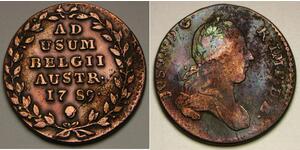(продана за $7.0)
1516-1526, Bohemia, Louis II. Scarce Silver Uniface Pfennig (Malý peníz) Coin.
Condition: About XF! Mint Place: Kuttenberg Mint Period: 1516-1526 Denomination: Uniface Pfennig (Kleinpfennig / Malý peníz) Diameter: 13mm Weight: 0.43gm Material: Silver
Obverse: Bohemian crown above large inital (L) of the Emperor, flanked by two letters (R-P).
Reverse: Blank (as usual for this uniface issue).
Louis II (Czech: Ludvík, Croatian: Ludovik, Hungarian: Lajos, Slovak: Ľudovít; 1 July 1506 – 29 August 1526) was King of Hungary, Croatia and Bohemia from 1516 to 1526. He was killed during the Battle of Mohács fighting the Ottomans, whose victory led to the Ottoman annexation of Hungary. He had no legitimate issue.
Vladislaus II took steps to ensure a smooth succession by arranging for the boy to be crowned in his own lifetime; the coronation of Louis as king of Hungary took place on 4 June 1508 in Székesfehérvár Basilica, and his coronation as king of Bohemia was held in 11 March 1509 in St. Vitus Cathedral in Prague.
In 1515 Louis II was married to Mary of Austria, granddaughter of Emperor Maximilian I, as stipulated by the First Congress of Vienna in 1515. His sister Anne was married to Mary's brother Ferdinand, then a governor on behalf of his brother Charles V, and later Emperor Ferdinand I. During the greater part of his reign he was the puppet of the magnates and kept in such penury that he was often obliged to pawn his jewels to get enough food and clothing. His guardians, Cardinal Tamás Bakócz and Count George Brandenburg-Ansbach, shamefully neglected him, squandered the royal revenues and distracted the whole kingdom with their endless dissensions. Matters grew even worse on the death of cardinal Bakócz, when the magnates István Báthory, John Zápolya and István Werbőczy fought each other furiously, and used the diets as their tools.
As king of Bohemia, Louis became known as "Ludovicus the Child". The first thaler coins were minted during his reign in Bohemia, later giving the name to the dollars used in different countries. These correctly style him as "LVDOVICVS•PRIM•D:GRACIA•REX•BO*" (Louis the First, by the grace of God King of Bohemia).
After his father's death in 1516, the minor Louis II ascended to the throne of Hungary and Croatia. Louis was adopted by the Holy Roman Emperor Maximilian I in 1515. When Maximilian I died in 1519, Louis was raised by his legal guardian, his cousin George, Margrave of Brandenburg-Ansbach.
Following the accession to the throne of Suleiman I, the sultan sent an ambassador to Louis II to collect the annual tribute that Hungary had been subjected to. Louis refused to pay the annual tribute and had the Ottoman ambassador executed and sent the head to the Sultan.[6] Louis believed that the Papal States and other Christian States including Charles V, Holy Roman Emperor would help him. This event hastened the fall of Hungary.
Hungary was in a state of near anarchy in 1520 under the rule of the magnates. The king's finances were a shambles; he borrowed to meet his household expenses despite the fact that they totaled about one-third of the national income. The country's defenses weakened as border guards went unpaid, fortresses fell into disrepair, and initiatives to increase taxes to reinforce defenses were stifled. In 1521 Sultan Suleiman the Magnificent was well aware of Hungary's weakness.
The Ottoman Empire declared war on the Kingdom of Hungary, Suleiman postponed his plan to besiege Rhodes and made an expedition to Belgrade. Louis failed to coordinate and gather his forces. At the same time, Hungary was unable to get assistance from other European states, which Louis had hoped for. Belgrade and many strategic castles in Serbia were captured by the Ottomans. This was disastrous for Louis' kingdom; without the strategically important cities of Belgrade and Šabac, Hungary, including Buda, was open to further Turkish conquests.
After the siege of Rhodes, in 1526 Suleiman made a second expedition to subdue all of Hungary. Louis made a tactical error when he tried to stop the Ottoman army in an open field battle with a medieval army, insufficient firearms, and obsolete tactics. On 29 August 1526, Louis led his forces against Suleiman in the disastrous Battle of Mohács. The Hungarian army was surrounded by Ottoman cavalry in a pincer movement, and in the center the Hungarian heavy knights and infantry were repulsed and suffered heavy casualties, especially from the well-positioned Ottoman cannons and well-armed and trained Janissary musketeers.
Nearly the entire Hungarian Royal army was destroyed in nearly 2 hours on the battlefield. During the retreat, the twenty-year-old king died when he fell backwards off his horse while trying to ride up a steep ravine of the Csele stream. He fell into the stream and, due to the weight of his armor, he was unable to stand up and drowned. As Louis had no legitimate children, Ferdinand was elected as his successor in the Kingdoms of Bohemia and Hungary, but the Hungarian throne was contested by John Zápolya, who ruled the areas of the kingdom conquered by the Turks as an Ottoman client.
Although Louis II's marriage remained childless, he probably had an illegitimate child with his mother's former lady-in-waiting, Angelitha Wass. This son was called John (János in Hungarian). This name appears in sources in Vienna as either János Wass or János Lanthos. The former surname is his mother's maiden name. The latter surname may refer to his occupation. "Lanthos" means "lutenist", or "bard". He received incomes from the Royal Treasury regularly. He had further offspring.

|
Добавил:
anonymous 2021-12-08 |
27 монет было добавлено с 2025-05-28 по 2025-06-04
Одна из них:
2 Liard Австрийские Нидерланды (1713-1795) Медь
в группе 4 монет / 4 цен
⇑

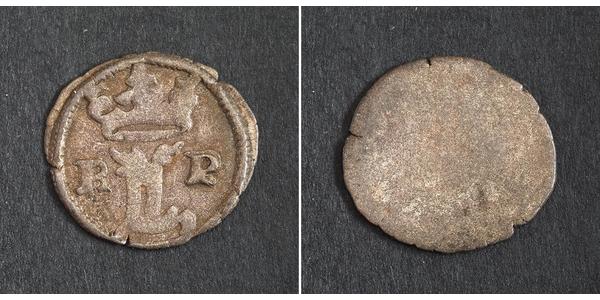




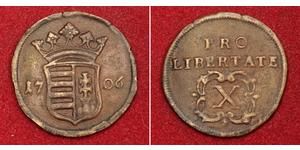



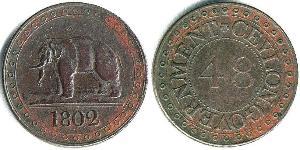

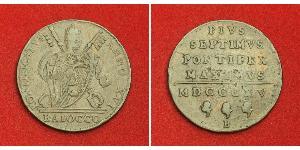

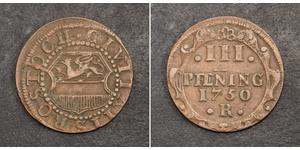

-300-150-N7QKX9ISGfEAAAFX9awaL_VH.jpg)
